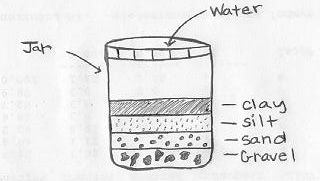
Your jar may look something like this, but depending on where you get your soil, it will have different amounts of clay, silt, sand and gravel.
Image by Kirstin Yogg
| Do you see the layers of clay, silt, sand and gravel? |
Soil is made up of clay, silt , sand and gravel. When soil is heavy, it has a lot of clay in it. When soil is light it has a lot of silt or sand in it. The size of the particles that make up the soil is what determines what the soil will be like. Gravel are the largest particles in soil and clay are the smallest.
|
|
Eco Info Most soil is really only half mineral. The rest is air, water and some organic animal and plant residue. |


